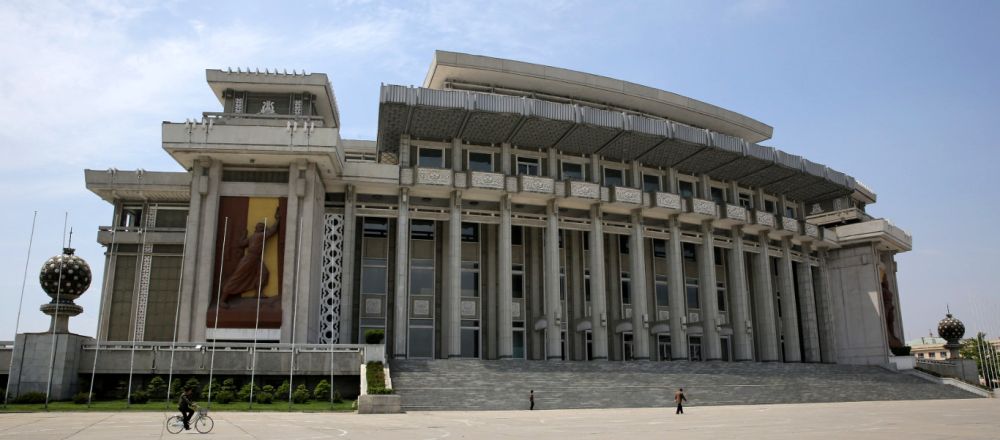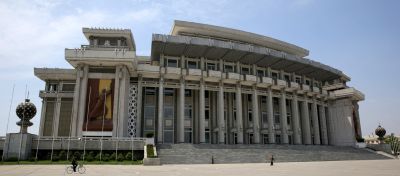

The Hamhung Grand Theatre is one of the largest performance venues in North Korea, boasting a magnificent architectural style. Visitors can take a guided tour to explore its grandiose halls and learn about the important cultural and political events that have taken place within its walls. Constructed during the nation's post-war reconstruction period, the theatre is a symbol of the resilience and artistic pride of the North Korean people. Beyond its historical significance, the tour provides a glimpse into the country's love for opera and ballet, both of which are popular art forms in North Korea. Additionally, tourists may have the rare opportunity to witness a live performance, although such events are subject to strict control by the authorities and availability may vary.
The Hamhung Revolutionary Museum is a site steeped in the political history of North Korea. Established to showcase the revolutionary achievements of the Workers' Party of Korea, the museum provides an in-depth look at the regional contributions to the country's liberation struggle and the development of socialism. With its wide array of artifacts, documents, and personal belongings of historical figures, the museum aims to inspire visitors with stories of sacrifice and dedication to the revolutionary cause. A guided tour will not only enlighten guests about North Korea's past but also provide insight into how history is taught and perceived within the country, reflecting the official narratives that play a significant role in the nation's collective identity. The experience is as much an educational journey as it is a window into the unique North Korean perspective on its history.
Majon Beach offers a rare opportunity to witness seaside relaxation North Korean-style. Located near Hamhung, the beach is famed for its fine sand and scenic beauty. Despite being a popular holiday site for locals, especially during the summer, the beach provides an unusual sense of seclusion from the typical bustling city life. Tourists can spend time sunbathing, enjoying the views of the East Sea, and observing how North Korean families and workers spend their leisure time. While swimming may not always be advisable due to certain restrictions, the experience of simply being on the beach can be refreshing. The beach also has several pavilions and snack bars, although the availability of services for foreign tourists can be limited and must usually be arranged through the tour guide.
As North Korea's second-largest city, Hamhung is home to an important industrial port. A visit to the port is a chance to understand the logistics and trade that support the region's economy, albeit from a distance and with little detailed information due to security concerns. Tourists can observe ships and the general port operations, getting a sense of the scale at which North Korea engages in maritime activities. It is also a unique opportunity to see workers in their work environment, giving a glimpse into the working life of the average North Korean citizen. As with many activities in North Korea, tours of sensitive areas like the port are strictly controlled and subject to government approval, often requiring special permissions that are handled by state-approved tour operators.
The Hungnam Fertilizer Complex is one of the largest of its kind in North Korea and a centerpiece of the nation's industrial capacity. While a tour of a fertilizer plant might seem unconventional, it is a chance to observe one aspect of North Korea's efforts to improve its agricultural productivity and self-sufficiency. Visitors can learn about the production processes and technologies employed at the complex, which holds significant importance to the country's economy and food supply. Note that visits to such industrial sites are carefully managed to show the best image of the country's infrastructure and might be canceled without prior notice if it's deemed inappropriate or if there are political sensitivities at the time.
Surrounded by hills and mountains, Hamhung offers beautiful landscapes for those interested in hiking and nature. Various trails are available, ranging from gentle walks to more challenging hikes. During these expeditions, visitors can enjoy panoramic views, encounter local flora and fauna, and possibly interact with local inhabitants. Outdoor activities such as hiking are one of the few moments when tourists can experience a degree of freedom from the usual constraints of structured tours, though they will still be accompanied by guides to ensure they do not stray from the officially sanctioned path. The chance to breathe in the fresh mountain air and temporarily escape the urban environment makes this activity a refreshing choice for visitors.
Hamhung boasts several monuments and statues that reflect the city's and the country's significant emphasis on its revolutionary history and its leaders. A city monument tour might include visits to various statues of Kim Il-sung and Kim Jong-il, war memorials, and monuments dedicated to ideological principles such as Juche and Songun. Each monument has a story, and guides are well-versed in the detailed narratives and importance of these sites, providing visitors with rich historical context. Although the subject matter of these tours is predominantly political, it is an essential aspect of understanding North Korean society and its values, as conveyed through its public art and memorials.
An integral part of any visit to a North Korean city is the central square, and Hamhung's is no exception. Often bustling with activity and local life, the square serves as a focal point for the city. It's a place where visitors can absorb the local atmosphere, observe propaganda displays and large public gatherings, and participate in state-organized festivities if their visit coincides with national celebrations. The vast open spaces, adorned with political symbols and statues, provide a stark representation of government presence and the collective culture prevalent in North Korean society.
A culinary experience in Hamhung offers a unique chance to taste local North Korean cuisine. The city is particularly known for Hamhung 'naengmyeon' (cold buckwheat noodles), a dish that has gained popularity throughout the Korean Peninsula. Dining in Hamhung allows visitors to engage with the local culture through food and experience dining as the locals do. It should be noted that restaurants designated for tourists often provide a more polished version of typical North Korean dishes, and the choices may be limited compared to what is available to the general population.
